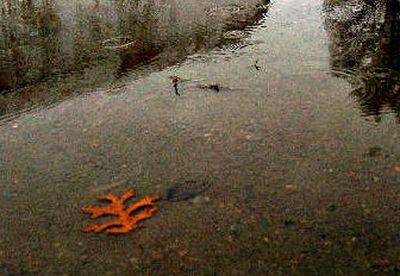West Nile warnings spring up

April showers could mean May mosquitoes.
The prospect of a bumper crop of biting bugs from the sodden spring weather is renewing concerns over West Nile virus, according to a warning issued this week by the Spokane Regional Health District.
Washington and North Idaho remain the last places in the lower 48 states untouched by the disease, but public health officials say this will likely change with the wet, mosquito-friendly weather.
“We’ve been expecting it for the last two years, but it hasn’t happened yet,” said Julie Graham, spokeswoman for the Spokane Regional Health District. “Every season that passes, the odds continue to climb.”
The mosquito that carries the virus is known to live in the Inland Northwest and has been found in Spokane. Officials can’t figure out why the region remains disease free.
“We all expected it to reach us by now,” said David Hylski, an epidemiologist with the Panhandle Health District.
Montana, Oregon and southern Idaho experienced their first human cases of the disease in the last two years. In Idaho, 13 people, 106 horses, 14 birds and one dog contracted the virus last summer. The first case was reported July 19, but most cases did not appear until late summer, according to information from the state’s Department of Health and Welfare.
The virus first appeared in North America in 1999 and has since spread across most of the nation. About 80 percent of those infected with the virus never show any of the tell-tale fever-like signs, but it can be fatal for a small percentage of those bitten by disease-carrying mosquitoes, according to the federal Centers for Disease Control and Prevention.
Long-sleeve clothing and bug spray can help deter mosquitoes, but public health officials say removing mosquito breeding areas is also one of the most effective ways of combating the disease. The insects breed in standing water, which is why the wet spring is causing concern, said Graham with the Spokane County Regional Health District.
“Mosquitoes don’t need much more than a thimble full of water to breed,” she said.
The wet weather not only has produced more puddles, it has created breeding pools in items such as flower pot basins and old tires. The high snowpack is also expected to contribute to the situation, Graham said, by recharging groundwater aquifers. Higher water tables often results in standing water in farm fields and yards.
Last year, the Spokane County health district proposed creating a mosquito control district, which would have given officials more power to spray larvicides in standing pools of water on private property.
Citing concerns over private property rights, Spokane County commissioners in June voted against allowing voters to decide whether to create such districts. The agency has no plans to try again this year to create a mosquito control district, Graham said.
“It was pretty clear last year there wasn’t any sort of momentum to move forward,” Graham said. “Mosquito control districts are definitely perceived by people who do this for a living as beneficial, but they’re political hot potatoes.”
The health district often gets complaint calls from residents concerned about neighboring properties with old tires and standing water, Graham said, but the district has no power to force a cleanup of mosquito breeding sites.
The Spokane County Building and Planning Department can require residents to properly store old tires or other water collectors, said Dave Jensen, senior land use planner with the agency. But he added, “We’re complaint driven. We don’t have the resources to go out and look for stuff.”